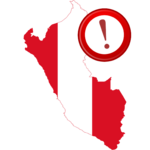| 2018 Peruvian agrarian protests | |
|---|---|
| Part of the 2017–2021 Peruvian political crisis | |
 Graphic image of the protest situation (3 February): Graphic image of the protest situation (3 February):Regions where the protests complied and/or expanded Regions where the protests ended Regions where protests were not followed Regions where they were not called and/or did not respond to the protests | |
| Date | 9 January – 11 February 2018 |
| Location | Peru |
| Caused by |
|
| Methods | |
| Casualties | |
| Death(s) | Two protesters |
| Peruvian political crisis |
|---|
 |
| Causes |
| Events |
|
| Elections |
| Protests |
| Armed violence |
|
|
The Peruvian agrarian strike of 2018 was a series of initially peaceful protests that took place from January 9 to February 11 in a large part of the Peruvian territory. The strike was performed by medium and small independent farmers who demanded that the government declare the agricultural sector in state of emergency due to serious deficiencies in production and trade, especially in the potato sector. On January 30, 2018 the demonstrations turned violent and expanded to departments that at first did not comply with the strike, until now the clashes between the National Police of Peru and the demonstrators left two people dead and serious material damage in the entire area.
Background
Since the rise to power of Pedro Pablo Kuczynski in 2016, Peru was involved in various protests from different areas, such as the education and health sector, the reactions to the pardon to former President Alberto Fujimori at the beginning of January 2018 and, at the same time, the resurgence of the political crisis that plagues the country.
The protests germinated when the national potato price collapsed tremendously due to the low prices of the same tuber exported from abroad by free trade agreements (FTAs) signed by Peru. Farmers called for the renegotiation of the FTAs and economic reparations that are caused by the loss of sales.
Strike
On January 9, the National Commission of Potato Producers announced the start of the strike with quiet protests in several cities of the Peruvian central highlands. After an agreement between farmers and the government, the demonstrations were halted. On January 25, the strikers expected the arrival of government representatives such as the President of the Council of Ministers, Mercedes Aráoz Fernández and the Minister of Agriculture and Irrigation, José Arista. On the agreed day, however, they did not arrive, and representatives of each state organization were sent in their place, and the strikers announced that, as a result, the strike would restart on January 30 but in a violent manner.
On January 30, demonstrators were blocking motorways and burning state installations in all departments, and in this case two deaths and numerous injuries were reported. On February 2 the main stage of the National Commission of Potato Producers reached an agreement with the government to lift the strike. This measure was only made official in the department of Ayacucho and some districts of other departments, this because the other Departmental proceedings are shown to be in disagreement with the ruling. Later in the same month, Ayacucho and other de facto districts would restart unemployment by a strikers majority that did not know what was agreed with the government.
On February 11 the Peruvian government managed to reach an agreement to buy the products exceeded the strikers, both the dissidents and the National Commission of Potato Producers lifted the strike.
See also
Notes
- "El gobierno anuncia el fin del paro agrario, pero la convulsión social no termina" [The government announces the end of the agrarian strike, but the social upheaval does not end] (in Spanish). La República. February 2, 2018. Retrieved September 4, 2018.
- "Paro agrario: Transportistas confrontan a manifestantes por bloqueo de la carretera Central" [Farmers' strike: Carriers face protesters over Central Highway blockade] (in Spanish). Diario Correo. February 2, 2018. Retrieved September 4, 2018.
- "Paro agrario: CNA exigen declarar en emergencia al sector" [Farmers' strike: CNA demand to declare the sector in emergency] (in Spanish). La República. February 2, 2018. Archived from the original on May 26, 2018. Retrieved September 4, 2018.
- "Paperos acuerdan iniciar paro indefinido este martes 30 de enero" [Potato farmers agree to start indefinite strike this Tuesday, January 30] (in Spanish). Página3. January 25, 2018. Archived from the original on August 25, 2018. Retrieved September 4, 2018.
- ^ "Esta es la cronología del paro en seis regiones del país" [This is the chronology of the strike in six regions of the country] (in Spanish). El Comercio. February 1, 2018. Retrieved September 4, 2018.
- "Paro agrario: el panorama en las regiones que protestan" [Farmers' strike: the outlook in the protesting regions] (in Spanish). El Comercio. February 1, 2018. Retrieved September 4, 2018.
- "Productores de papa confirman acuerdo y levantan paro agrario tras diálogo con Minagri" [Producers of potatoes confirm agreement and lift rural strike after dialogue with Minagri] (in Spanish). La República. February 2, 2018. Retrieved September 4, 2018.
- "Productores de papa en Huánuco, Ayacucho y Apurímac siguen en protesta" [Producers of potatoes in Huánuco, Ayacucho and Apurímac continue in protest] (in Spanish). América TV. February 2, 2018. Retrieved September 4, 2018.
- "Gobierno autoriza compra de excedentes de papa hasta por S/50 millones" [Government authorizes purchase of surplus potatoes up to S/50 million] (in Spanish). El Comercio. February 11, 2018. Retrieved September 4, 2018.
External links
- "Paro agrario: Puntos para entender el conflicto entre productores de papa y el Estado" [Farmers' strike: Points to understand the conflict between potato producers and the State] (in Spanish). Perú 21. February 2, 2018. Retrieved September 4, 2018.